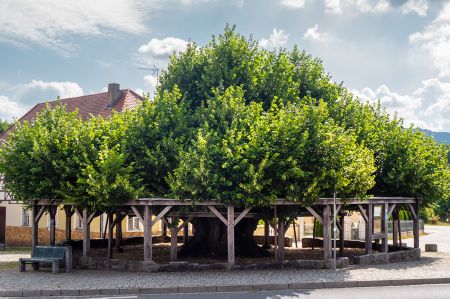Tanzlinden - trees of historically special importance and function
- Written by Portal Editor
On our tours through small towns and communities, we often noticed linden trees that had been planted in village squares for special occasions and therefore, in addition to their function as a source of shade and oxygen, must have other meanings in the lives of the residents.
Depending on the type, linden trees reach a maximum growth height of between 15 (e.g. the Crimean linden) and 40 meters. The achievable trunk diameter also varies from species to species, usually between 1 and 1.8 meters. Lime trees can reach an age of up to 1000 years in favourable locations.
Linden Leaf Tea ("Ihlamur Çayı") a very popular herbal tea
 In addition to the tree itself, the use of linden blossom is widespread among the population. Already in the Middle Ages, the linden blossom was known as a remedy and is still used with good success today as the most well-known home remedy for feverish colds, influenza infections and catarrh of the upper respiratory tract and as an accompanying treatment for rheumatism, nephritis and sciatica.
In addition to the tree itself, the use of linden blossom is widespread among the population. Already in the Middle Ages, the linden blossom was known as a remedy and is still used with good success today as the most well-known home remedy for feverish colds, influenza infections and catarrh of the upper respiratory tract and as an accompanying treatment for rheumatism, nephritis and sciatica.
There are studies on its ingredients, for example, lime blossom tea has a soothing effect on coughing and soothes a sore throat due to the mucilage in catarrhs of the respiratory tract. Other ingredients such as glycosides give lime blossom an antispasmodic, analgesic and anti-inflammatory effect.
 Linden leaf tea ("Ihlamur Çayı") is a very popular herbal tea in Turkey and is used in Turkish culture to treat all kinds of ailments. The entire inflorescence with the associated bract is used for the production of tea. The harvest takes place up to five days after flowering and ideally on a dry morning. The dried linden blossoms are yellowish to greenish, but the brewed tea is deep golden-red in colour.
Linden leaf tea ("Ihlamur Çayı") is a very popular herbal tea in Turkey and is used in Turkish culture to treat all kinds of ailments. The entire inflorescence with the associated bract is used for the production of tea. The harvest takes place up to five days after flowering and ideally on a dry morning. The dried linden blossoms are yellowish to greenish, but the brewed tea is deep golden-red in colour.
The linden tree was considered a sacred tree by both the Slavs and the Germans, which is popularly attributed to the goddess Freya, but this cannot be clearly proven scientifically. Today, around 850 places or districts in Germany have names that can be traced back to the lime tree, for example the name of the city of Leipzig is derived from the Sorbian word Lipsk and means lime tree place. The Sorbs have many other connections to the linden tree, so the linden leaf is also a symbol of the Sorbian people.
Idea for the German Dance Linden Route born in Limmersdorf
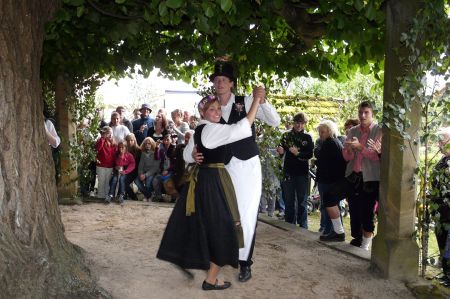 The village court was usually held under the village linden trees, a tradition that goes back to the Germanic court assembly, the Thing. The lime tree is therefore also known as the "court tree" or "court lime tree".
The village court was usually held under the village linden trees, a tradition that goes back to the Germanic court assembly, the Thing. The lime tree is therefore also known as the "court tree" or "court lime tree".
Lime trees used to be planted in many places across Central Europe, forming the centre of the town and serving as a meeting place in the village for young and old. Current news was exchanged here, brides were also presented here. A custom of the Middle Ages was also to plant a peace linden tree after wars or epidemics, so linden trees were planted in many places after the Franco-Prussian War of 1870/71. In Ponitz, Thuringia, the "Peace Linden Tree on the Dreierhäuschen" is a reminder of the Peace of Westphalia.
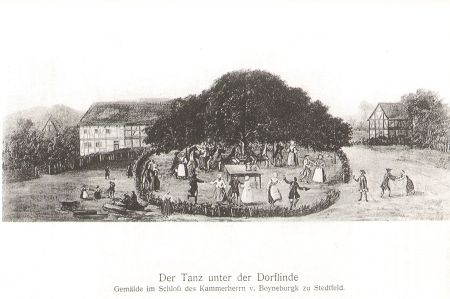 The so-called Türkenlinde von Ottendorf is the name of a pair of linden trees that are supposed to commemorate the failed siege of the city of Vienna by the Turks in 1683. According to local tradition, the two trees were planted in 1683 by Frankish soldiers who had taken part in the liberation of Vienna from the Turkish siege. In 1686 the linden trees were cut into spherical trees. In 1750, linden branches were tied into a ring that still encloses the two trees today. Because of the increasing weight of the horizontal branches, two concentric rows of piers were set in 1789 to support the ring. The grey sandstone pillars were supplied by the stonemason Ankenbrand from Falkenstein, who was paid 40 guilders by the municipality.
The so-called Türkenlinde von Ottendorf is the name of a pair of linden trees that are supposed to commemorate the failed siege of the city of Vienna by the Turks in 1683. According to local tradition, the two trees were planted in 1683 by Frankish soldiers who had taken part in the liberation of Vienna from the Turkish siege. In 1686 the linden trees were cut into spherical trees. In 1750, linden branches were tied into a ring that still encloses the two trees today. Because of the increasing weight of the horizontal branches, two concentric rows of piers were set in 1789 to support the ring. The grey sandstone pillars were supplied by the stonemason Ankenbrand from Falkenstein, who was paid 40 guilders by the municipality.
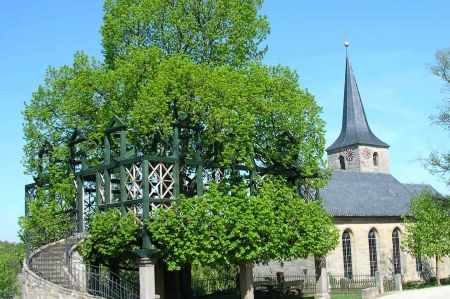 With the beginning of the merry month of May, dance festivals are often celebrated under these trees. We encountered a very special kind of dancing linden tree in the town of Limmersdorf, where people call for dancing on a platform that is supported by the lower branches of the village linden tree. This is also where the idea for the German Dancing Lime Tree Route was born, when it was discovered during the preparations for the German Dancing Lime Tree Museum that these dancing linden trees are mainly found in a few German regions and that they exist there almost as if strung on a string of pearls. If you combine these parts, the result is an amazing and impressive tour around the Franconian part of southern Germany.
With the beginning of the merry month of May, dance festivals are often celebrated under these trees. We encountered a very special kind of dancing linden tree in the town of Limmersdorf, where people call for dancing on a platform that is supported by the lower branches of the village linden tree. This is also where the idea for the German Dancing Lime Tree Route was born, when it was discovered during the preparations for the German Dancing Lime Tree Museum that these dancing linden trees are mainly found in a few German regions and that they exist there almost as if strung on a string of pearls. If you combine these parts, the result is an amazing and impressive tour around the Franconian part of southern Germany.
It quickly turned out that in the region of Upper Franconia-Thuringia along the route from Limmersdorf via Langenstadt and Peesten to Effelder, Sachsenbrunn and Oberstadt - the last six remaining old and authentic locations, the classics so to speak - this old tradition was most intensively developed and has been maintained in the most sustainable way to date. Along this "Route of the Classics" there are other places where linden trees still exist, which prove the formerly widespread distribution of linden trees (Franconian Switzerland, Nördlicher Rennsteig).
 To the west, in Hesse, is the Schwalm-Eder region with a number of neighbouring locations extending into the Rheingau; the oldest linden tree in Germany in Schenklengsfeld is certainly outstanding.
To the west, in Hesse, is the Schwalm-Eder region with a number of neighbouring locations extending into the Rheingau; the oldest linden tree in Germany in Schenklengsfeld is certainly outstanding.
Hohenlohe in Baden-Württemberg, a region traditionally closely linked to Franconia, has emerged as the third region in which this tradition was and is demonstrably long and deeply rooted. A row of linden trees in Westphalia, which extends to the Lower Rhine, but which have no verifiable roots in the regions described above - formerly also used for dance purposes - is out of the ordinary.
Stepped lime trees around Schweinfurt
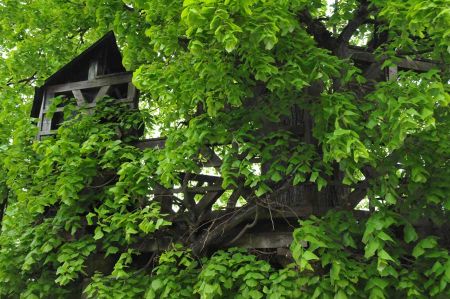 Individual other locations without any particular regional tradition are scattered throughout Germany; At some locations, new dancing linden trees are also planted in these years because the idea has been taken up elsewhere.
Individual other locations without any particular regional tradition are scattered throughout Germany; At some locations, new dancing linden trees are also planted in these years because the idea has been taken up elsewhere.
The stepped linden trees around Schweinfurt are a striking feature, and some villages in Thuringia have obviously been based on them. There is a row of multi-tiered linden trees, which are often referred to as dancing linden trees, but actually never fulfilled this function.
The proclamation of the German Dance Linden Route in 2010 should be a cornerstone for the work of the German Dance Linden Museum. All communities, associations and individuals who are interested in the topic at one of these locations are cordially invited to participate. Over time, this cooperation should result in a great map and an organization of whatever kind, which ensures that the locals and visitors are comprehensively informed about the Tanzlinden at all locations.
An interesting idea to keep this ancient heritage alive.
Please read as well:
The Waterfall of Edessa - short trip into the city
Schönbrunn Palace and the Roman Ruin
